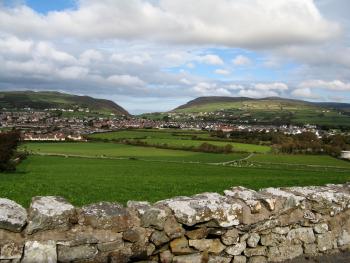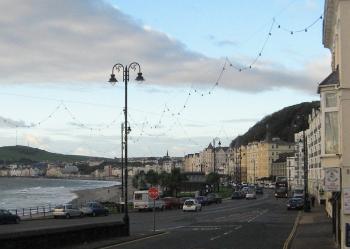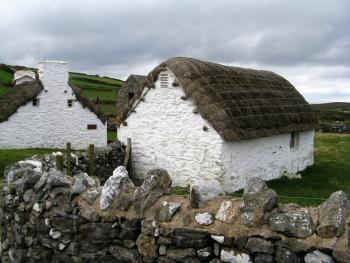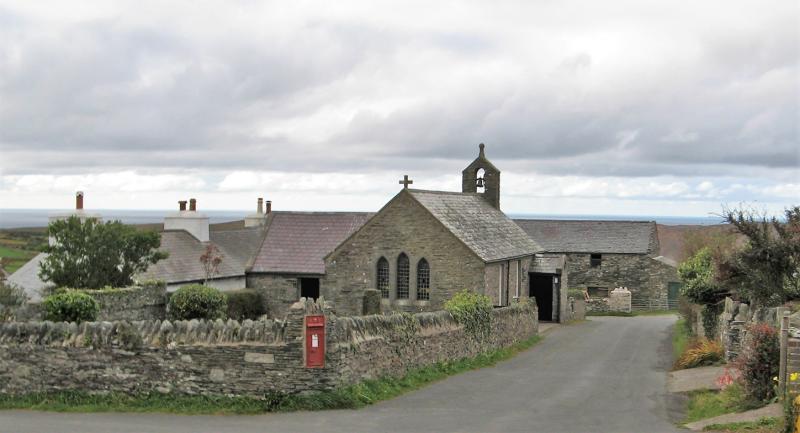Stepping back in time on the Isle of Man
This article appears on page 20 of the July 2017 issue.
In October 2016, my husband, Mike, and I visited one of the oldest democracies on Earth. You might think I’m talking about Iceland, but, no, the place with the oldest continuously meeting parliamentary government is the Isle of Man.
Iceland’s parliamentary democracy, the Althing (Alþingi) was established in 930, but it lapsed for a number of years. The Isle of Man’s Tynwald was established in 979 and has met every year since then.
Located in the middle of the Irish Sea, the Isle of Man is roughly equidistant from England, Ireland, Scotland and Wales. It measures only 32 miles by 14 miles, about the size of Guam or Andorra.
It’s not a part of the United Kingdom, although the UK handles its international affairs and defense. Technically, it isn’t part of the Commonwealth of Nations (formerly the British Commonwealth) either, but the Isle of Man participates in activities such as the Commonwealth Games. It is designated as a Crown Dependency, like the islands of Jersey and Guernsey in the English Channel.
The Isle of Man is renowned for low taxes, both business and personal, and thrives on offshore financial dealings and tourism.
This island nation issues its own currency, which is equal to the British pound. (The British pound is accepted on the Isle of Man, but the Isle of Man pound is not usable in the UK.)
Leaving from Liverpool
We started our journey at the ferry terminal in the city of Liverpool, in northwestern England, which turned out to be a pleasant place. The Liverpool Maritime Mercantile City is a UNESCO-designated World Heritage Site, and its port is an attractive part of the UNESCO-designated section of the city.
During the industrial revolution, Liverpool’s port was vital to the economy of England, but in the 1900s, new container ships required a deeper port.
Outdated, Liverpool’s Albert Dock was closed in 1972, and the area fell into disrepair. Recently, however, this area has been revitalized, and it now features apartments, office space and tourist attractions.
The port area is a stop on the city’s hop-on/hop-off bus tour, which offers easy access to the rest of the city.
We chose to stroll along the riverside promenade to watch the river traffic. There we found a small exhibit called The Beatles Story. Of course, I had my picture taken with the life-size statue of the Beatles, holding Paul’s hand.
The Isle of Man Steam Packet Company (phone +44 8722 992 992, www.steam-packet.com) operates ferries to the Isle of Man from Liverpool, Heysham, Belfast and Dublin. We bought our ferry tickets online ($190, with a car) for the 4-hour evening crossing to Douglas, the island’s capital, and arrived in time for a late check-in at one of the dozens of hotels in the city.
Douglas is set on a tranquil bay, with a broad, 2-mile-long avenue that runs in a crescent around its beach. The street is lined with stately Victorian hotels and tourist shops, and a horse-drawn trolley carries visitors back and forth.
Out to explore
We spent two days driving around the island. Given its small size, you can circle the island in a day, but it would be hard to explore without a car. The roads are winding and narrow, and some are only one lane wide, though they accommodate 2-way traffic. At times, we rode for miles hoping no one would come from the other direction.
Driving (on the left) around the island is not for the faint-hearted, but the scenery was breathtaking! Picturesque views popped up around every turn: rugged coastlines; charming houses with thatched roofs; pastures dotted with sheep, and fields separated by stone walls. Low mountains spanned the center of the island, offering panoramic vistas.
We strolled through Cregneash, a preserved 19th-century village featuring whitewashed cottages, farms and a megalithic chambered tomb. The site is a living museum, with furniture and tools of the era as well as demonstrations of traditional daily activities such as weaving, woodworking, smithing and cooking. There are more than 40 points of interest and several hiking trails in the area.
Manx Loaghtan sheep, a rare breed native to the Isle of Man, are bred in Cregneash. These sheep, nearly extinct in 1950 before a breeding program brought their numbers back, are characterized by their multiple horns (up to six) and brown fleece. They are prized for their low-cholesterol meat, a delicacy on the island.
Just a few miles up the west coast is Port Erin, a resort town that became popular in the Victorian Era. With a broad sand beach, this pleasant little town might be a more quiet base for touring.
Farther north is Niarbyl, a small rocky cove with just a few houses. There we met two men who were repairing a thatch roof. They were very sociable and took time away from their work to chat and advise us on our journey.
“Waking Ned Devine” was filmed on the Isle of Man, and many scenes were shot at Niarbyl and Cregneash. The government promotes filmmaking, so you just might come across an active film site somewhere on the island. Sixteen films (including parts of one of the Harry Potter films) and dozens of TV programs have been filmed there.
During our trip, we struck up conversations with several people who were cheerful and welcoming. When they found out we were from the US, they universally thought we were there to research our ancestry. It would seem few Americans go there just for the visit, which is a shame.
Historic sites
Continuing north, we stopped in Peel, a fishing port that boasts a castle and a cathedral. Smoked kippers are big business there and are shipped internationally. These small, oily herring snacks, prepared whole by butterflying, have a strong, fishy taste.
In Peel, we visited the House of Manannan, a museum that focuses on the long history and culture of the island. Prehistoric sites date back more than 5,000 years, and evidence of Mesolithic, Neolithic, Bronze Age and Iron Age habitation has been found. Recorded history dating back more than 1,000 years reveals an intertwined mix of Irish, English, Scottish and Norwegian rule.
A replica of a Viking longship, Odin’s Raven, was built in 1979 to sail from Norway to Peel to celebrate 1,000 years of democracy, and it is now set up on the main floor of the museum, with its “men” exiting the boat through the front window.
On our way back to Douglas we stopped at Tynwald Hill, which has been a gathering place for government for over 1,000 years. A session of Parliament is held outdoors there on Midsummer Day (aka Tynwald Day), July 5th, and it is attended with great pomp and circumstance. All laws passed that year are read out on that day.
When available, the Lord of Man — Queen Elizabeth II — is in attendance. In 1765, the British Parliament purchased the rights of the then-Lord of Man and gave them to the British Crown, and the masculine title has been handed down to the country’s monarchs to this day.
On our second day of exploration, we headed up the island’s east coast, stopping in Laxey.
In the 19th century, Laxey boomed due to its lead, copper, silver and zinc mining. The mines, closed in 1929, and the giant waterwheel, originally built to pump water out of the mines and generate power for the town, are now just tourist attractions.
We climbed to the top of the 72-foot-diameter waterwheel for a fine view of the surrounding countryside.
Planning your visit
One thing the people of the Isle of Man are passionate about is the Isle of Man TT, a premier event in the world of motorcycle racing. This 2-week event takes place in June on 37 miles of local roads.
The races have been described as frenetic, covering narrow, winding, stone-walled, mountainous roads. Winning motorcycles average 130 mph and reach up to 200 mph on certain segments of the race. Is it any wonder that from 1907 to 2015, there have been 246 fatalities of competitors and spectators?
The Manx Grand Prix, considered the amateurs’ version of the TT, is held in late August. To avoid the crowds, you might want to skip these months if planning a visit.
We spent only two days on the Isle of Man and did not have enough time to visit all that we had intended to see. The island has more adventures awaiting our return — wilderness trails, fishing, railways, cycling, prehistorical ruins, castles, museums and Dark Sky Discovery Sites (areas of darkness that allow glorious views of the Milky Way and beyond).
The Isle of Man’s tourism website (visitisleofman.com) is well designed and gives a comprehensive overview of the possibilities for visitors. You can time your visit to see basking sharks, the second-largest living fish, off the island’s southwest coast, or stay on Calf of Man, a bird sanctuary that is deserted in the winter. But be sure to allow time for relaxing on the beach or enjoying water sports.




